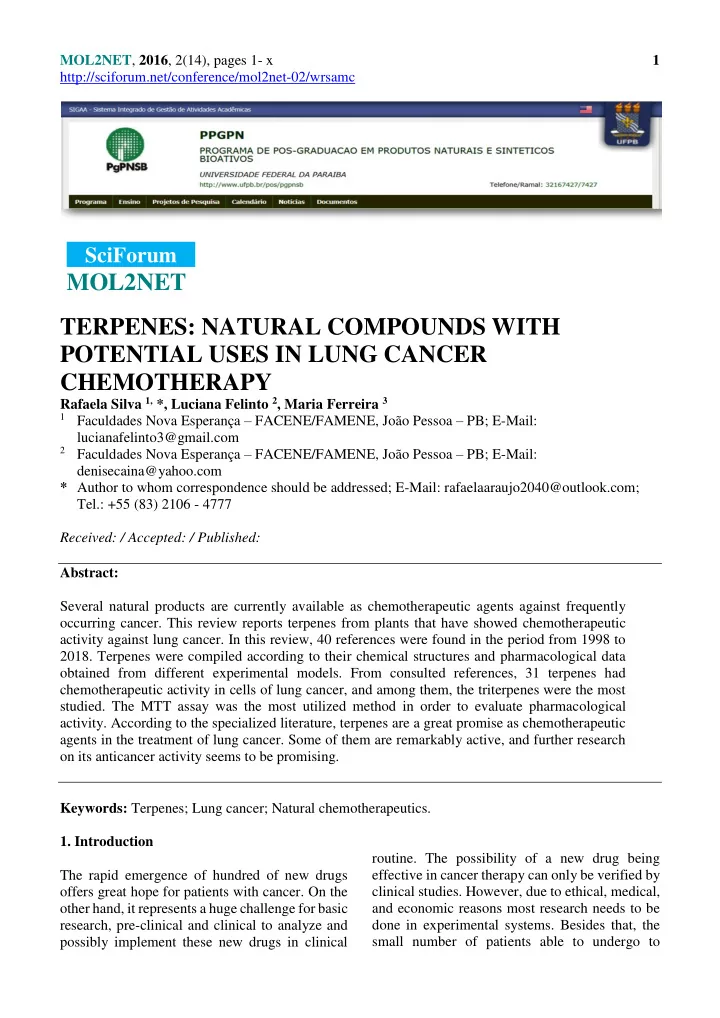

MOL2NET , 2016 , 2(14), pages 1- x 1 http://sciforum.net/conference/mol2net-02/wrsamc SciForum MOL2NET TERPENES: NATURAL COMPOUNDS WITH POTENTIAL USES IN LUNG CANCER CHEMOTHERAPY Rafaela Silva 1, *, Luciana Felinto 2 , Maria Ferreira 3 1 Faculdades Nova Esperança – FACENE/FAMENE, João Pessoa – PB; E-Mail: lucianafelinto3@gmail.com 2 Faculdades Nova Esperança – FACENE/FAMENE, João Pessoa – PB; E-Mail: denisecaina@yahoo.com * Author to whom correspondence should be addressed; E-Mail: rafaelaaraujo2040@outlook.com; Tel.: +55 (83) 2106 - 4777 Received: / Accepted: / Published: Abstract: Several natural products are currently available as chemotherapeutic agents against frequently occurring cancer. This review reports terpenes from plants that have showed chemotherapeutic activity against lung cancer. In this review, 40 references were found in the period from 1998 to 2018. Terpenes were compiled according to their chemical structures and pharmacological data obtained from different experimental models. From consulted references, 31 terpenes had chemotherapeutic activity in cells of lung cancer, and among them, the triterpenes were the most studied. The MTT assay was the most utilized method in order to evaluate pharmacological activity. According to the specialized literature, terpenes are a great promise as chemotherapeutic agents in the treatment of lung cancer. Some of them are remarkably active, and further research on its anticancer activity seems to be promising. Keywords: Terpenes; Lung cancer; Natural chemotherapeutics. 1. Introduction routine. The possibility of a new drug being effective in cancer therapy can only be verified by The rapid emergence of hundred of new drugs offers great hope for patients with cancer. On the clinical studies. However, due to ethical, medical, other hand, it represents a huge challenge for basic and economic reasons most research needs to be research, pre-clinical and clinical to analyze and done in experimental systems. Besides that, the possibly implement these new drugs in clinical small number of patients able to undergo to
MOL2NET , 2016 , 2, N, pages 1- x 2 clinical testing is another important limitation for podophyllotoxin and its derivative (etoposide, testing new anticancer medicines. For many years, teniposide), camptothecin, and others (Bhanot et researchers in the cancer pharmacology field have al., 2011). developed The use of natural products is the most successful safe and reliable methods in vivo and in vitro for strategy aiming discovering new anticancer assessing the effectiveness of many drug compounds. Different mechanisms of action were candidates (Capellozi, 2009). identified for plant-derived Classical chemotherapy offers a number of anticancer drugs, such as interaction with DNA, chemicals that help in the treatment and healing of enzyme inhibition and interaction with other injuries caused by lung carcinoma (LC). proteins. All mechanisms aim the blockage of Paclitaxel and platinum derivatives (cisplatin or cancerous cell cycle, and the compounds have as carboplatin) are widely used, with a effective an essential requirement the maximum distinction response in 25% of cases. In addition to the between the cancerous and the normal cells chemotherapy, the surgery (lobectomy, (Alberts, et al., 2003). pneumonectomy and segmentectomy) and radiotherapy can complete the therapeutic In recent years a large number of natural products scheme. Despite these treatment options, a great from plants such traditional Chinese herb is percentage of patients do not respond to the shown highlighted as potential inhibitors of cell treatment and the need to implement new proliferation, induce apoptosis, angiogenesis alternatives to combat injuries caused by LC suppressors, and delay metastasis and enhance the increases each day. (Bezerra, et al., 2008). action of other substances chemotherapy, exhibiting in vitro and in vivo anticancer activity. Plants have been used since ancient times as Among these natural products we can mention the medicines by population, providing good sources terpenes, one of the larger groups of naturally of pharmacologically active compounds to occurring secondary metabolites. They are present improving the therapeutic arsenal (Silva et al., in many plants, marine organisms, and in common 2006; Costa et al., 2009). Vegetable species are foods such as apples and olives, and have showed considered promising source of molecules for many pharmacological activities combined with a treatment of various cancer types and it is low toxicity profile. All these characteristics led significant that over 50% of currently used anti- to raise researchers interest in testing terpenes cancer agents were developed from natural pharmacological actions, and many important sources (Cragg et al., 2005). Even if the isolated activities have already been proved, e.g., anti- natural product could not be strictly used as a inflammatory, analgesic, antipyretic, cardiotonic, medicine, it is often a model for synthesis or and anticancer activities (Bishayee et al., 2011; structural modifications in order to develop new Silva et al., 2009b). chemotherapeutic agents (Brandão et al., 2010). By knowing the anticancer potential of terpenes Drugs originated from natural sources that are part and the activities already established in literature, of the anticancer arsenal include the terpenes the present work aim to compile the anticancer derivatives taxanes (paclitaxel, docetaxel), vinca terpenes actives against lung carcinoma (LC), based on studies in vitro and in vivo. alkaloids (vincristine and vinblastine), anthracyclines (doxorubicin, daunorubicin, etc.), well as in algae, moss, lichens, and some are found in mammals (Pan & Ho, 2008). 2. Results and Discussion Terpenes or terpenoids compose a diverse class of Several terpenes isolated from many plant species natural compound or secondary metabolites from have shown anticancer activities on various tumor plant origin. They can be found in the leaves, cell lines, among them the lung cancer cell lines (A549) (ACS, 2009). Monoterpenes, diterpenes, flowers, seeds, wood and roots of higher plants as sesquiterpenes and triterpenes were assayed
Recommend
More recommend